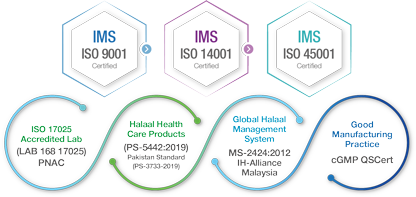

More than 200 Distributors
Around 1,000,000 Outlets
Nationwide Coverage
Aaram
(Diclofenac Sodium)
Brand Name
Aaram
Generic Name
(Diclofenac Sodium)
Therapeutic Segment
Anti-Rheuamtic

Scan QR code to open on your mobile device.
Available as
- CAPSULE
- AARAM 50MG CAPSULE
PRESCRIBING INFORMATION:
(Summary of product characteristics)
WARNING: RISK OF SERIOUS CARDIOVASCULAR AND GASTROINTESTINAL EVENTS.
- Nonsteroidal anti-inflammatory drugs (NSAIDs) cause an increased risk of serious cardiovascular thrombotic events, including myocardial infarction and stroke, which can be fatal. This risk may occur early in treatment and may increase with duration of use.
- It is contraindicated in the setting of coronary artery bypass graft (CABG) surgery.
- NSAIDs cause an increased risk of serious gastrointestinal (GI) adverse events including bleeding, ulceration, and perforation of the stomach or intestines, which can be fatal. These events can occur at any time during use and without warning symptoms.
- Elderly patients and patients with a prior history of peptic ulcer disease and/or GI bleeding are at greater risk for serious GI events.
QUALITATIVE AND QUANTITATIVE COMPOSITION
Aaram 50mg Capsules:
Each capsule contains:
Diclofenac Sodium USP ….. 50mg
(As Enteric Coated Pellets)
(Product Specs.: Bosch )
Aaram SR 100mg Capsules:
Each capsule contains:
Diclofenac Sodium Sustained Release Pellets
to Diclofenac Sodium ….. 100mg
(Product Specs.: BP)
PHARMACEUTICAL FORM
Capsules
CLINICAL PARTICULARS
THERAPEUTIC INDICATIONS:
Aaram and Aaram SR capsules are indicated for:
- Rheumatoid arthritis; osteoarthritis.
- Low back pain; acute musculo-skeletal disorders and trauma such as periarthritis (especially frozen shoulder), tendinitis, tenosynovitis, bursitis, sprains, strains and dislocations.
- Relief of pain in fractures.
- Ankylosing spondylitis.
- Acute gout.
- Control of pain and inflammation in orthopedic, dental and other minor surgery.
POSOLOGY AND METHOD OF ADMINISTRATION
For oral use
Adults: The recommended initial dose is 100 -150 mg diclofenac daily. In milder cases, in young people over 16 years of age or for long-term treatment, 50 – 100 mg per day is usually sufficient preferably with food or after food.
The capsules must not be divided or chewed.
Pediatric Population: Not recommended
Special populations
Elderly patients: It should be used with caution in elderly patients and the lowest effective dose used for the shortest possible duration. These patients should be monitored regularly for GI bleeding during NSAID therapy.
Hepatic Impairment: Patients with hepatic disease may require reduced doses compared to patients with normal hepatic function.
CONTRAINDICATIONS:
Known hypersensitivity to diclofenac sodium.
Active gastric or intestinal ulcer, bleeding or perforation.
History of gastrointestinal (GI) bleeding or perforation, related to previous non-steroidal anti-inflammatory drug (NSAID) therapy or history of recurrent peptic ulcer or hemorrhage (two or more distinct episodes of proven ulceration or bleeding).
Patients who have previously shown hypersensitivity reactions (e.g. asthma, rhinitis, angioedema or urticaria) in response to ibuprofen, aspirin, or other NSAIDs.
Acute porphyria.
Severe hepatic, renal or cardiac failure.
During the last trimester of pregnancy.
Established congestive heart failure (NYHA II-IV), ischemic heart disease, peripheral arterial disease and/or cerebrovascular disease.
Special Warnings and Precautions for Use
General: Undesirable effects may be minimised by using the lowest effective dose for the shortest duration necessary to control symptoms.
Caution is indicated in the elderly on basic medical grounds. In particular, it is recommended that the lowest effective dose be used in frail elderly patients or those with a low body weight.
Concomitant use systemic NSAIDs including cyclooxygenase-2 selective inhibitors should be avoided due to the absence of any evidence demonstrating synergistic benefits and the potential for additive undesirable effects.
As with other NSAIDs, allergic reactions, including anaphylactic/anaphylactoid reactions, can also occur in rare cases with diclofenac without earlier exposure to the drug. Hypersensitivity reactions can also progress to Kounis syndrome, a serious allergic reaction that can result in myocardial infarction. Presenting symptoms of such reactions can include chest pain occurring in association with an allergic reaction to diclofenac.
Like other NSAIDs, diclofenac may mask the signs and symptoms of infection due to its pharmacodynamic properties.
Gastrointestinal effects:
The risk of GI bleeding, ulceration or perforation is higher with increasing NSAID doses, in patients with a history of ulcer, particularly if complicated with hemorrhage or perforation, and in the elderly.
To reduce the risk of GI toxicity in patients with a history of ulcer, particularly if complicated with hemorrhage or perforation, and in the elderly, the treatment should be initiated and maintained at the lowest effective dose.
Caution is advised in patients receiving concomitant medications that could increase the risk of ulceration or bleeding, such as systemic corticosteroids, anticoagulants such as warfarin, anti-platelet agents such as aspirin or selective serotonin-reuptake inhibitors.
Caution should also be exercised in patients with ulcerative colitis or Crohn’s disease, as their condition may be exacerbated. NSAIDs, including diclofenac. Close medical surveillance and caution are recommended when using diclofenac after GI surgery.
Hepatic effects:
During prolonged treatment with diclofenac, regular monitoring of hepatic function is indicated as a precautionary measure. If abnormal liver function tests persist or worsen, if clinical signs or symptoms consistent with liver disease develop, or if other manifestations occur (e.g. eosinophilia, rash), it should be discontinued. Hepatitis may occur with use of diclofenac without prodromal symptoms. Caution is called for when using in patients with hepatic porphyria, since it may trigger attack.
Renal effects:
As fluid retention and edema have been reported in association with NSAID therapy, including diclofenac, particular caution is called for in patients with impaired cardiac or renal function, history of hypertension, the elderly, patients receiving concomitant treatment with diuretics or medicinal products that can significantly impact renal function, and in those patients with substantial extracellular volume depletion from any cause, e.g. before or after major surgery.
Monitoring of renal function is recommended as a precautionary measure when using in such cases. Discontinuation of therapy is usually followed by recovery to the pre-treatment state.
Cardiovascular and cerebrovascular effects:
Patients with significant risk factors for cardiovascular events (e.g. hypertension, hyperlipidemia, diabetes mellitus, smoking) should only be treated with diclofenac after careful consideration. As the cardiovascular risks of diclofenac may increase with dose and duration of exposure, the shortest duration possible and the lowest effective daily dose should be used. Appropriate monitoring and advice are required for patients with a history of hypertension and/or mild to moderate congestive heart failure as fluid retention and edema have been reported in association with NSAID therapy.
Respiratory disorders:
In patients with asthma, seasonal allergic rhinitis, swelling of the nasal mucosa (i.e. nasal polyps), chronic obstructive pulmonary diseases or chronic infections of the respiratory tract (especially if linked to allergic rhinitis-like symptoms), reactions on NSAIDs like asthma exacerbations (so-called intolerance to analgesics / analgesics-asthma), Quincke’s edema or urticaria are more frequent than in other patients. Therefore, special precaution is recommended in such patients (readiness for emergency).
This is applicable as well for patients who are allergic to other substances, e.g. with skin reactions, pruritus or urticaria.
Caution is required if administered to patients suffering from, or with a previous history of, bronchial asthma, since NSAIDs have been reported to cause bronchospasm in such patients.
Hematological:
During prolonged treatment with diclofenac, as with other NSAIDs, monitoring of the blood count is recommended. It can reversibly inhibit platelet aggregation. Patients with defects of hemostasis should be carefully monitored.
SLE and mixed connective tissue disease:
In patients with systemic lupus erythematosus (SLE) and mixed connective tissue disorders there may be an increased risk of aseptic meningitis.
Dermatological:
Serious skin reactions, some of them fatal, including exfoliative dermatitis, Stevens-Johnson syndrome and toxic epidermal necrolysis, have been reported very rarely in association with the use of NSAIDs. Patients appear to be at highest risk for these reactions early in the course of therapy, the onset of reaction occurring in the majority of cases within the first month of treatment. Should be discontinued at the first appearance of skin rash, mucosal lesions or any other sign of hypersensitivity.
Impaired Female fertility:
The use may impair female fertility and is not recommended in women attempting to conceive. In women who have difficulties conceiving or who are undergoing investigation of infertility, withdrawal of it should be considered.
Interaction with other medicinal products and other forms of interaction
Lithium: It may increase plasma concentrations and decrease elimination of lithium.
Cardiac glycosides: NSAIDs may exacerbate cardiac failure and reduce GFR. If used concomitantly, may raise plasma concentrations of digoxin.
Anticoagulants and anti-platelet agents: Concomitant administration could increase the risk of bleeding. There are reports of an increased risk of hemorrhage in patients receiving diclofenac and anticoagulants concomitantly.
Antidiabetic agents: It can be given together with oral hypoglycemic agents without influencing their clinical effect. However, there have been isolated reports of hyperglycemic and hypoglycemic effects, which have required adjustments to the dosage of hypoglycemic agents. Monitoring of serum lithium level, serum digoxin level, blood glucose level is recommended as a precautionary measure during concomitant therapy.
Ciclosporin: Nephrotoxicity may be increased by the effect of NSAIDs, including diclofenac, on renal prostaglandins. Therefore, it should be given at doses lower than those that would be used in patients not receiving ciclosporin.
Mifepristone: NSAIDs should not be used for 8-12 days after mifepristone administration as NSAIDs can reduce the effect of mifepristone.
Methotrexate: It can inhibit the tubular renal clearance of methotrexate thereby increasing methotrexate levels.
Caution should be exercised if NSAIDs, including diclofenac, and methotrexate are administered within 24 hours of each other, since NSAIDs may increase methotrexate plasma levels with decreased elimination, resulting in increased toxicity.
Quinolone antibiotics: NSAIDs can increase the risk of convulsions associated with quinolone antibiotics. Patients taking NSAIDs and quinolones may have an increased risk of developing convulsions.
Selective serotonin reuptake inhibitors (SSRIs): Increased risk of GI bleeding.
Other analgesics including cyclooxygenase-2 selective inhibitors: Avoid concomitant use of two or more systemic NSAIDs (including aspirin) as this may increase the risk of adverse events.
Corticosteroids: Systemic corticosteroids can increase the risk of GI ulceration or bleeding.
Diuretics and antihypertensive agents: Like other NSAIDs, concomitant use of diclofenac with diuretics or antihypertensive agents (e.g. beta-blockers, angiotensin converting enzyme (ACE) inhibitors) may cause a decrease in their antihypertensive effect.
Patients should be adequately hydrated and consideration should be given to monitoring of renal function after initiation of concomitant therapy and periodically thereafter, particularly for diuretics and ACE inhibitors due to the increased risk of nephrotoxicity. Concomitant treatment with potassium-sparing drugs may be associated with increased serum potassium levels, which should therefore be monitored frequently.
Tacrolimus: Possible increased risk of nephrotoxicity when NSAIDs are given with tacrolimus.
Zidovudine: Increased risk of hematological toxicity when NSAIDs are given with zidovudine. There may be an increased risk of hemarthroses and hematoma in HIV (+) hemophiliacs receiving concurrent treatment with zidovudine and ibuprofen.
Phenytoin: When using phenytoin concomitantly with diclofenac, monitoring of phenytoin plasma concentrations is recommended due to an expected increase in exposure to phenytoin.
Colestipol and cholestyramine: These agents can induce a delay or decrease in absorption of diclofenac. Therefore, it is recommended to administer diclofenac at least one hour before or 4 to 6 hours after administration of colestipol or cholestyramine.
Potent CYP2C9 inhibitors: Caution is recommended when co-prescribing diclofenac with potent CYP2C9 inhibitors (such as voriconazole), which could result in a significant increase in peak plasma concentration and exposure to diclofenac due to inhibition of its metabolism.
Fertility, Pregnancy and Lactation:
Safety during pregnancy and lactation has not been established.
Pregnancy
During the first and second trimester of pregnancy, diclofenac should not be given unless clearly necessary. If diclofenac is used by a woman attempting to conceive, or during the first and second trimester of pregnancy, the dose should be kept as low and duration of treatment as short as possible.
Lactation
It can appear in breast milk in very low concentrations with traces found in breast milk following oral doses of 50mg every eight hours. Therefore, it should not be administered during breastfeeding in order to avoid undesirable effects in the infant.
Fertility: It may impair female fertility and is not recommended in women attempting to conceive.
Effects on ability to drive and use machines
Patients who experience visual disturbances, dizziness, vertigo, somnolence, central nervous system disturbances, drowsiness or fatigue while taking Diclofenac, should refrain from driving or operating machinery.
Undesirable effects
Adverse reactions listed below are classified according to frequency and System Organ Class (SOC). Frequency categories are defined according to the following convention: Very common (≥ 1/10), Common (≥ 1/100 to < 1/10), Uncommon (≥ 1/1,000 to < 1/100), Rare (≥ 1/10,000 to < 1/1,000), Very rare (< 1/10,000), Not known (cannot be estimated from the available data).
|
System organ class |
Adverse reaction |
Frequency |
|
Blood and lymphatic system disorders |
Thrombocytopenia, leucopenia, anemia (including hemolytic and aplastic anemia), ag ranulocytosis. |
Very rare |
|
Neutropenia. |
Unknown |
|
|
Immune system disorders
|
Hypersensitivity, anaphylactic and anaphylactoid reactions (including hypotension and shock). |
Rare |
|
Angioneurotic edema (including face edema). |
Very rare |
|
|
Psychiatric disorders |
Disorientation, depression, insomnia, nightmare, irritability, psychotic disorder. |
Very rare |
|
Confusion, hallucinations. |
Unknown |
|
|
Nervous system disorders |
Headache, dizziness. |
Common |
|
Optic neuritis. |
Unknown |
|
|
Somnolence. |
Rare |
|
|
Paresthesia, memory impairment, convulsion, anxiety, tremor, aseptic meningitis (especially in patients with existing auto-immune disorders, such as systemic lupus erythematosus, mixed connective tissue disease) with symptoms such as stiff neck, headache, nausea, vomiting, fever or disorientation; taste disturbances, cerebrovascular accident. |
Very rare |
|
|
Eye disorders |
Visual disturbance, vision blurred, diplopia. |
Very rare |
|
Ear and labyrinth disorders |
Vertigo |
Common |
|
Tinnitus, hearing impaired |
Very rare |
|
|
Cardiac disorder |
Palpitations, chest pain, cardiac failure, myocardial infarction. |
Very rare |
|
Kounis syndrome |
Unknown |
|
|
Vascular disorders |
Hypertension, vasculitis. |
Very rare |
|
Respiratory, thoracic & mediastinal disorders |
Asthma (including dyspnea). |
Rare |
|
Pneumonitis. |
Very rare |
|
|
Aggravated asthma, bronchospasm. |
Unknown |
|
|
Gastrointestinal disorders |
Nausea, vomiting, diarrhea, dyspepsia, abdominal pain, flatulence, anorexia. |
Common |
|
Gastritis, gastrointestinal hemorrhage, hematemesis, diarrhea hemorrhagic, melena, gastrointestinal ulcer (with or without bleeding or perforation) sometimes fatal particularly in the elderly. |
Rare |
|
|
Colitis (including hemorrhagic colitis and exacerbation of ulcerative colitis or Crohn’s disease), constipation, stomatitis (including ulcerative stomatitis), glossitis, esophageal disorder, diaphragm-like intestinal strictures, pancreatitis. |
Very rare |
|
|
Ischemic colitis |
Unknown |
|
|
Hepatobiliary disorders |
Transaminases increased. |
Common |
|
Hepatitis, jaundice, liver disorder. |
Rare |
|
|
Fulminant hepatitis, hepatic necrosis, hepatic failure. |
Very rare |
|
|
Skin and subcutaneous tissue disorders |
Rash. |
Common |
|
Urticaria. |
Rare |
|
|
Bullous eruptions, eczema, erythema, erythema multiforme, Stevens-Johnson syndrome, toxic epidermal necrolysis (Lyell’s syndrome), dermatitis exfoliative, loss of hair, photosensitivity reaction, purpura, allergic purpura, pruritus. |
Very rare |
|
|
Renal and urinary disorders |
Acute renal failure, hematuria, proteinuria, nephrotic syndrome, interstitial nephritis, renal papillary necrosis. |
Very rare |
|
General disorders |
Edema |
Rare |
|
Fatigue, malaise. |
Unknown |
Overdose
- Special measures such as forced diuresis, dialysis or hemo-perfusion are probably of no help in eliminating NSAIDs, including diclofenac, due to the high protein binding and extensive metabolism.
- Activated charcoal may be considered after ingestion of a potentially toxic overdose, and gastric decontamination (e.g. vomiting, gastric lavage) after ingestion of a potentially life-threatening overdose.
- Renal and liver function should be closely monitored. Patients should be observed for at least four hours after ingestion of potentially toxic amounts.
- Frequent or prolonged convulsions should be treated with intravenous diazepam.
Pharmacological Properties
Pharmacodynamic Properties
Pharmacotherapeutic group: Non-steroidal anti-inflammatory drugs and anti-rheumatic drugs, acetic acid derivatives and related substances.
ATC code: M01AB05
Mechanism of action
Diclofenac Sodium is a non-steroidal agent with marked analgesic/anti-inflammatory and anti-pyretic properties. It is an inhibitor of prostaglandin synthetase (cyclo-oxygenase).
Pharmacokinetic properties
Absorption
Diclofenac Sodium is rapidly absorbed from the gut and is subject to first-pass metabolism.
Distribution
It gives peak plasma concentrations after approximately 2.5 hours. The active substance is 99.7% protein bound and plasma half-life for the terminal elimination phase is 1-2 hours. Only 35 – 70% of the absorbed active ingredient reaches the post hepatic circulation unchanged.
Biotransformation and Elimination
Approximately 60% of the administered dose is excreted via the kidneys in the form of metabolites and less than 1% in unchanged form. About 30% of the dose is excreted via the bile in metabolized form.
Diclofenac sodium slow-release preparation
- Increases the duration of action of the drug.
- Maintains relatively constant rate of absorption in the gastro-intestinal tract over a longer period of time.
- Increases the fraction of the ingested dose absorbed in the GI tract.
- Regulates the rate at which the drug is made available for absorption, thereby reducing the possibility of malabsorption and occurrence of side-effects.
PHARMACEUTICAL PARTICULARS
Incompatibilities
Not known
Shelf life:
Aaram 50mg Capsules: 3 years
Aaram SR 100mg Capsules: 2 years
Special precautions for storage
- Protect from heat, sunlight & moisture, store below 30°C.
- The expiration date refers to the product correctly stored at the required condition.
- Keep out of the reach of children.
- To be sold on the prescription of a registered medical practitioner only.
PRESENTATION:
Aaram 50mg capsules: Pack of 20 Capsules.
Aaram SR 100mg capsules: Pack of 20 Capsules.
REGISTRATION HOLDER / MARKETING AUTHORIZATION HOLDER
Head Office:
Bosch Pharmaceuticals (Pvt.) Ltd.,
8, Modern Society, Tipu Sultan Road, Karachi-75350 (Pakistan)
Manufacturing Site:
Bosch Pharmaceuticals (Pvt.) Ltd.,
Plot No. 221-223, Sector 23, Korangi Industrial area Karachi, Pakistan
MARKETING AUTHORISATION NUMBER(S)
Aaram 50mg Capsules: 030798
Aaram SR 100mg Capsules: 116023
DATE OF FIRST AUTHORISATION/RENEWAL OF THE AUTHORISATION
Aaram 50mg Capsules: 09.08.2003/08.08.2023
Aaram SR 100mg Capsules: 05.07.2023
DATE OF REVISION OF THE TEXT
30.12.2023

